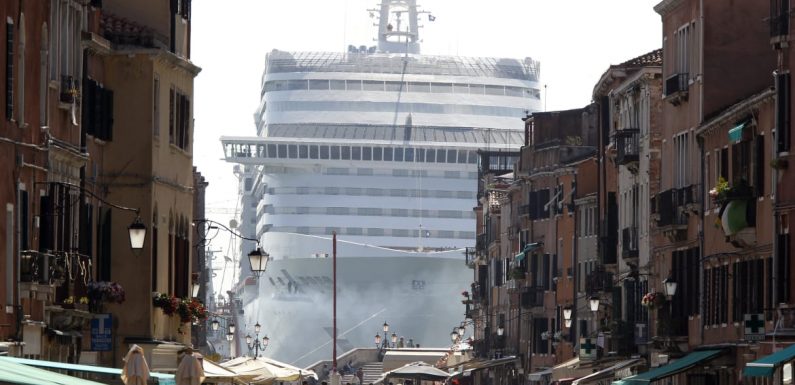
VENICE—On June 5, the MSC Orchestra cruise ship will once again glide past Venice’s St. Mark’s square despite a March 31 government decree banning the monster ships from the city center. It won’t be a sign of defiance, but rather a sign of compromise as the city prepares the new temporary cruise ship port in decidedly unpicturesque Marghera. The area used to be a swamp—in fact the name means “the sea was here”—and now it houses an oil refinery and several other industrial plants which might not be what cruise ship passengers are expecting when they dock in Venice. The passengers would then take the train or smaller boats into historical Venice, about 20 minutes away.
The new decree by Prime Minister Mario Draghi’s infant government that prohibits passenger ships over 40,000 tons, as well as container ships, from passing close to the historical city center is backed by environmentalists and many Venetians.
Load Error
“Anyone who has visited Venice in recent years has been shocked to see these ships, hundreds of metres long and as tall as apartment buildings, passing through such fragile places,” Italy Culture Minister Dario Franceschini said when announcing the news.
But some in the city say the return of the cruise ships will be a welcome sign. “It will really feel like things are getting back to normal again,” Vincenzo, who used to sell souvenirs to the tourists at a shop near St. Marks Square until he shuttered his shop when the tourists stopped coming, told The Daily Beast. He now spends his time shuffling around the empty city, wondering if he will ever open again. “I have to pay rent, I have to pay electricity, but it is not worth opening until I know the tourists are back.”
Venice’s long-standing inner struggle with self-identity has become glaringly apparent during the COVID-19 pandemic. In 2019, around 25 million tourists visited the city, which has a fixed population of under 60,000. The crush of tourists had turned the UNESCO World Heritage site into something of a Disneyland with plans then in place to install turnstiles to control the flow in and out of the historical center. But by February 2020, when the pandemic caused the cancellation of Carnival, tourism ground to a halt. “There were a few tourists this summer, but in the thousands, not millions,” City councilor Simone Venturini said. “And everyone suddenly had to stop and think: Do we want them or not?”
Before the pandemic, around 1.6 million cruise ship passengers visited Venice each year, but they are among the most loathed in the city because they eat and sleep on the ships and don’t contribute anything but human traffic to the city. Before the pandemic, around 700 massive ships entered the lagoon each year. None have been back since, though the sector will open up in June.
Cruise ships have been proven to damage the fragile lagoon bed because of the amount of water they displace, but despite the historic center’s animosity the industry is one of the most lucrative for the greater Venice region, bringing around $450 million annually and employing 4,000 people with permanent jobs—who have almost all been furloughed since early 2020.
Since the pandemic, Venice has struggled with how to reinvent itself once borders are open and travelers can return. Many who want to see Venice return to the golden era of the Grand Tour, actually believe it is low-cost airlines that contribute far more of the “wrong” kind of tourists to Venice, not the cruise ships.
But Draghi’s decree doesn’t actually deliver a full stop to the ships—at least not for now. Negotiations between Venetians who are working to come up with plans to reopen Venice safely had pleaded with the government to do its part to keep the ships from coming too close to the historical center. But the fine print of Draghi’s ban says the government intends to build a new port, even calling for a competition of ideas for how to safely keep the ships at bay, whether at sea or on land—not that it will build one. The winner will get €2.2 million to carry out the plan.
But to even temporarily house the ships at Marghera on the mainland, the narrow channel leading up to it will have to be dredged to make it deeper and not risk the sort of Suez Canal debacle the Ever Given container ship caused this spring.
“The decree is a joke,” Marco Gasparinetti, a city councilor who would like to see a total ban on the ships, wrote on his Facebook page. “Governments change in Italy every 14 months, there is no way this decree will stay in place.”
Venice’s mayor Luigi Brugnaro doesn’t want the ships to be turned away. “People will understand in a few years that disembarking tourists from a cruise ship in the sea doesn’t work in any part of the world,” he said after the decree was announced. “Leave them where they are.”
Back in an empty St. Mark’s square on a recent April day, Vincenzo longs for the return of the tourists, no matter how they get here. “We’ve seen what Venice is like with just Venetians now for more than a year,” he said. “We need company again.”
Read more at The Daily Beast.
Source: Read Full Article










